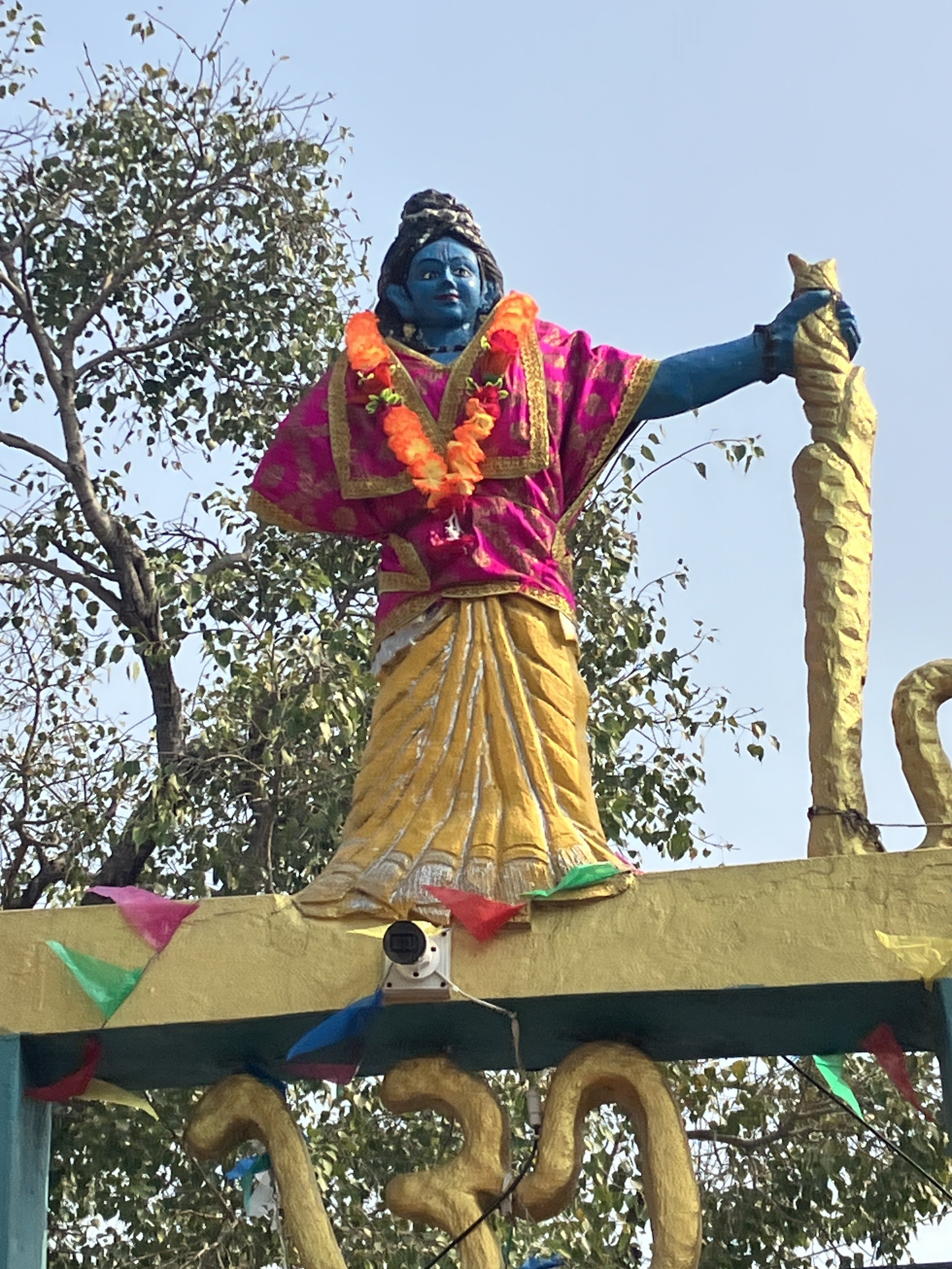Sharayu Wadekar is an architectural historian, a researcher and a storyteller.
“ I am Sharayu, a student of Architecture and History.
I always thought I think in terms of spatiality- an interdisciplinary understanding of real-life vocabulary into that of personal desire.
A desire to make sense of this world that keeps falling out of my institutional dialect. “
The world has problems, and universities have disciplines
- Garry Brewer
What are the different ways of seeing. Photo courtesy of the author.
I don't know who I am writing to, but I think it's you, as a woman, we share an invisible relationship with this place, Janakpurdham. In contrast, I am a visitor or a tourist, another one to have walked this land as you—as they claim did Sita, Ram, and Janak. Don't you think Ram occupies the slogans and flags, while Sita is considered a visitor? Do you think she is a visitor, too?
Part 1
How do you construct a landscape? Is it constructed already or do people exist to shift and move across the land of multi-marginalized species through the perception of an ancestral memory and desire to multiply?
Part 2
Who is a pilgrim?
Just Like a classic Bojack horseman 10-second monologue- I thought I was a researcher before I came to this place before I met people. Then I heard them and I thought I was only a visitor.
I wanted to write a letter. I didn’t want to ‘edit’ the challenges, or reinforce or counter question over ‘authenticity’ because nothing is authentic. People move, landscapes change, and time makes every assumption queer.
Vivaha Panchami is an event. For a lot of women in Bihar and the people of Janakpurdham. Who are these women from Bihar and Janakpurdham- how are these distinctions perceived?
Janakpurdham - a place that can be theorized into volumes if we engage alphabetically and politically. But does this question deepen the crisis it seemingly portrays?
So what is the crisis exactly about?
Is it the friction between the temporary displacement of gendered bodies in space- almost like a spectacle of a certain kind of public within the public domain? A huge mass movement of cross-border bodies through a religious crucible that maps the atmosphere into peripheral spatiotemporally across the existing geo-political landscape densified with social, and cultural complexities.
Walls of god. Photo courtesy of the author.
Part 3
A recurring motif in Janakpurdham’s religio-heritage-driven landscape- is a pond. These ponds become not only a kind of landscape but places of asserting and maintaining an ideology- performativity of its reproduction. These ponds, ostensibly communal spaces, have been circumscribed into the orbit of temple complexes, becoming extensions of a Hinduized ideology. The construction of this ideology is not subtle; it is loud, sharp, and firm- the tolls of bells reinforced by rituals like the three types of aartis performed on the same pond or the casual assertion of control through temple-sponsored festivals. What is most telling, however, is how these ponds, one of the common's land are now sites of exclusion, gendered in how they are accessible, while ideologically, and psychologically restricted. Who gets to claim the pond? And what kind of claims are that for the ‘commons’? The question is less about physical proximity and more about symbolic ownership, a performance of control that masks itself as a nostalgic tradition.
The roads- I see women walking barefoot- to the temple and the farms. The long roads cut straight through the fields and fences such that the traces of bricks and mortar follow until around the temple precinct, as dust, concrete, and people. These runover boundaries then translate through farms that slip through as forests and plantations, turning institutions into thresholds of radical conversations and conversions, public land into fields of exclusion, and kin-caste-based economy.
The cultural heritage precinct map. Photo courtesy of the author.
Part 4
At the heart of everyday dynamics is labor, both visible and invisible. The ponds do not maintain themselves; the temples do not build or clean themselves; the streets do not organize themselves for festivals. This labor is carried out by the very bodies that these spaces marginalize; Dalits, women, Muslims, and other oppressed groups based on their degrees of ability. Their labor sustains the city’s religious-heritage and infrastructure, yet their presence remains at the thinning of its narrative.
This erasure of labor is not incidental; it is structural, built into the fabric of a city that prioritizes symbols over people. The issue of access extends beyond the physical and into the ideological. Consider the Manusmriti sold in local libraries, a text that codifies caste-based exclusion as divine law. Its presence in Janakpurdham’s intellectual spaces is not an accident but a statement; a reminder of the ideological underpinnings that justify and perpetuate exclusion. It is a chilling juxtaposition: a city that claims to honor Sita, a symbol of devotion and resilience, simultaneously endorses a text that denies dignity to so many of its kind.
Yet, to reduce Janakpurdham’s problems to the dominance of symbolism and heritage would be to oversimplify a more complex reality. While these forces are undeniable, they interact with other dynamics like economic inequality, gendered labor, and the commodification of landscapes in order to create a more nuanced landscape of exclusion. The Hindu tea vendor’s (who worked as a human pulley in Mumbai, India) cartography along road expansions is not separate from the Muslim community’s exclusion from ponds or the women’s brief reclamation of streets during Vivaha Panchami. These are not isolated but interconnected, intersectional- in broader structures of categorized marginalization.
How do we proceed from here? How do we narrate stories in binaries when this effort only simplifies the atmospheres of terror, crisis, resistance, and rebellion? Can we translate the comfort the Muslim men share within the premises wrapped in the walls of the mosque? The lived fabric is made of many narratives, like that of Mamta didi, a Dalit reporter who ‘collects stories’ of other Dalit women in Janakpurdham with a bare trust in the state or other fellow Hindus. When asked about her views on Janakpurdham, she shows numbness. Her landscape of life runs along making everyday needs meet- she is quite indifferent to the celebration of sita and ram.
The many heads of many divine. Photo courtesy of the author.
Part 5
As I write this, I am acutely aware of my position, as physical through the systematic mobility from peripheries to the city, as a visitor, a researcher, and a participant in the academic-industrial complex. Am I contributing to the very exclusion I seek to critique? Is my writing another form of erasure, one that prioritizes analysis over observation, over engagement, over action? These are uncomfortable questions, but they are necessary. To engage critically with Janakpurdham, or any city with a history of religious heritage, is to confront not only its exclusions but also our complicity in them. These are often shaped as dilemmas rather than moments of eureka.
The two degrees of exclusion in Janakpurdham, religious heritage construction and collateral infrastructure are not unique to this city. They are symptomatic of a broader pattern in South Asia, where history is weaponized to justify inequality, and modernity is wielded as a tool of displacement. What makes Janakpurdham particularly poignant is its scale: a relatively small city that encapsulates the broader struggles of access, labor, and belonging. Its ponds, roads, and festivals are microcosms of a larger narrative, one that demands critical engagement.
As a visitor from a place of privilege, the challenge before us is not merely to document or reinforce these exclusions through deviation but instead to disrupt them- to complicate these obvious manifestations. This requires a shift of focus, like a psychedelic trip that trembles the land and becomes fluid from critiquing the symptoms to addressing the structures, from analyzing the visible to uncovering the invisible. It means questioning not only the dominance of Hindutva but also the ideologies of progress and modernity that enable exclusion and their marriage. It means acknowledging the labor that sustains these spaces and ensuring that this labor is not erased from their right to narratives.
It is not so much about who gets these structures built but who builds them? Can we move beyond this passive role to actively disrupt these structures, to challenge not just the manifestations of exclusion but their ideological foundations? To write about Janakpurdham is to participate in its construction. The deeper we inquire, the more assumptions start to tremble. In this case, question becomes, what kind of construction are we enabling and why now?












